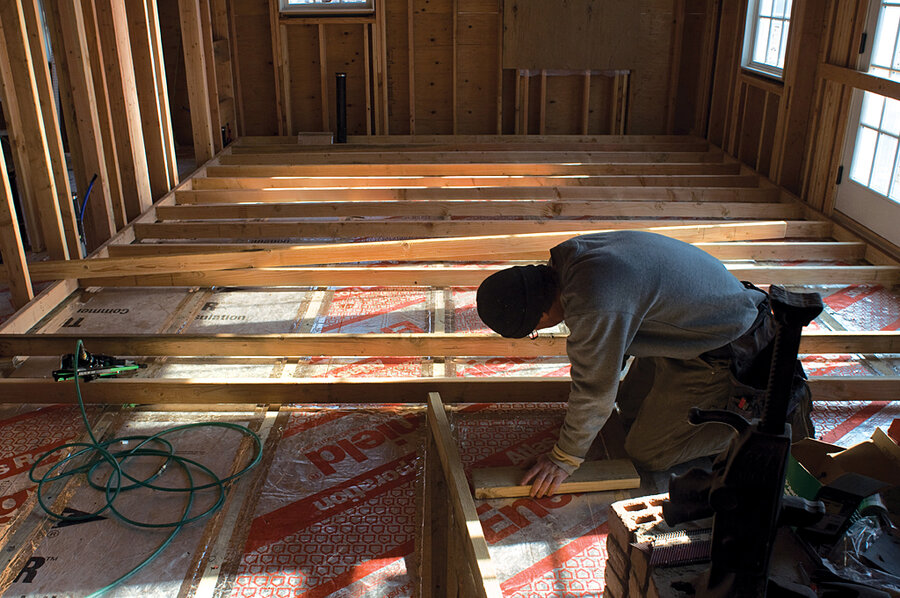Green building costs not always included in home appraisal
Loading...
Building green is one of the few phenomena firing up the nation's slumped residential real estate market. In large part, that consumer demand is fueled by the fact that a green home can save as much as 30 to 60 percent over a conventional house to heat and cool.
But even as more hammers swing in green construction, potential purchasers of environmentally friendly homes are finding that it isn't always easy to get them appraised correctly and financed.
The problem is threefold: a lack of education among appraisers about the costs and benefits of green construction; insufficient data for them to calculate the value of environmental benefits; and finally, real estate listing services that, in many parts of the country, do not take into account attributes such as solar panels and spray foam insulation in their market valuations.
Solutions for these problems are still being developed.
Money-saving features don't appraise higher
"What we're finding is that the appraisal process, the lending process, the underwriting process for loans still hasn't caught up with the market interest in green building," says Kevin Morrow, senior program manager for the National Association of Home Builders' green programs. "If a builder builds a home that may cost a little more than an identical home next door, yet it has all kinds of efficiency features that will eventually mean that it's less costly to operate, it often won't appraise [for a higher value]."
In Chapel Hill, N.C., for example, Michael Chandler designed a home to be small, environmentally efficient, and solar. But in order for the appraisal to be high enough for prospective owners to qualify for a bank loan, the house had to be modified.
"We had to go back and strip out some energy features like the solar water heaters and cut back on insulation and add square footage, making it bigger and less [energy-] efficient to get to the $400,000 appraisal," says Mr. Chandler, owner of Chandler Design-Build. "Houses that are dramatically more efficient than normal, on average cost $15,000 to $20,000 more than houses built to code standard, but that's not being reflected in the appraisals."
A good example is the way home insulation is valued by a conventional appraisal. Inexpensive fiberglass batts that meet the minimum required by building code are usually estimated to have the same dollar value in a house as more expensive but highly effective foam insulation, although the batts can jack up the monthly cost of operating the home.
"The appraisal industry needs to have well-accepted mechanisms with which to upgrade the values of energy-efficient properties, much like they do with granite countertops or hardwood floors or fireplaces," says Mark Nuzzolo, owner of Brookside Development in Woodbridge, Conn.
Education to address the issues
The Appraisal Institute, a nonprofit educational and professional organization whose members account for more than a quarter of the nation's 100,000 appraisers, is beginning to address the issues. It has developed several courses and seminars as well as a green certificate program for appraisers who want to qualify.
"You don't get this type of analysis when you're going through the normal education process to be certified at the state level," says Leslie Sellers, an appraiser in Knoxville, Tenn., and 2010 president of the Appraisal Institute. "In order to do this, you have to take additional education over and above that."
Appraisers don't set the market value of a property, they simply measure it, Mr. Sellers notes. If there's no market evidence that a solar water heater increases the value of a home in a certain area, then the appraiser isn't going to place any value on it.
That's especially true in a changing market such as the current one. "We often work with market data that is six months old," says Sellers.
The banking community may help create some of that needed, green-market data. Some banks have begun to offer $1,000 off closing costs for homes that qualify as energy efficient. The government-backed mortgage giant Fannie Mae is expected to announce a green incentive program with at least one large bank to encourage more homeowners to use part of their mortgages for energy-efficiency upgrades.
The Department of Energy and the Environmental Protection Agency's EnergyStar program have announced the expansion of a similar green mortgage program already operating in Colorado and Maine. It allows homeowners to invest in efficiency upgrades and pay for them during the life of the loan, the interest on which is also tax deductible.
"Green building is still in its infancy," says Mr. Nuzzolo. "Technological advances have radically changed – and are radically changing – the way we build houses. The banking and mortgage industries need to be educated. We all have to keep things moving forward."





